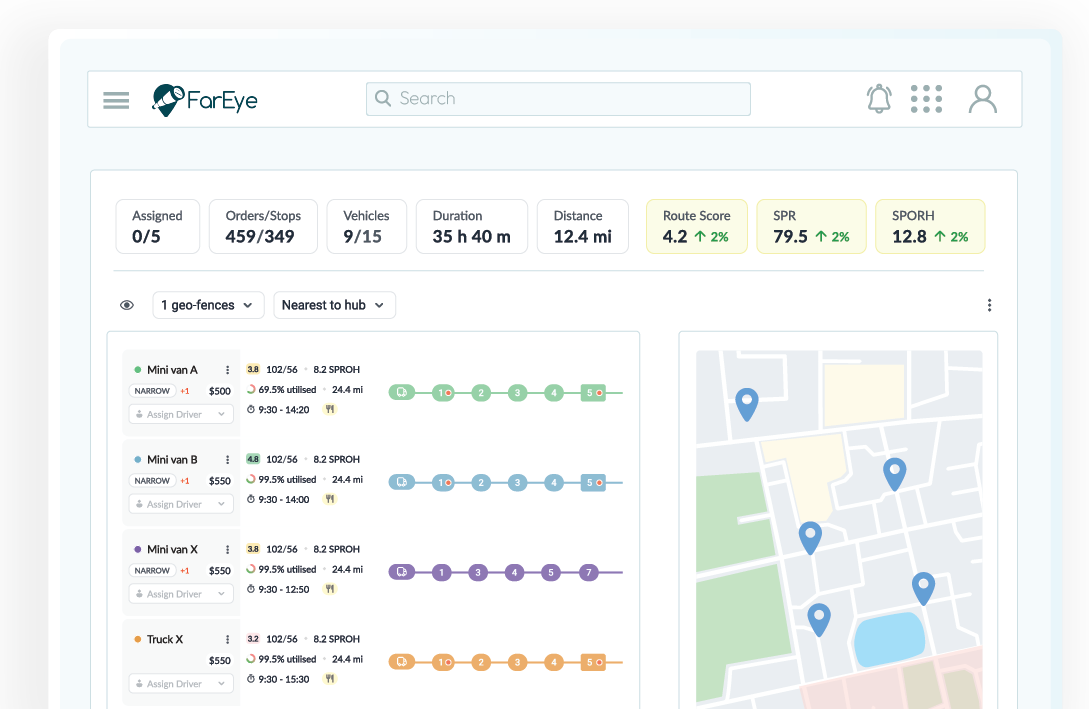- Delivery Routing
Best Practices for Implementing Delivery Routing Software Across Large Fleets
Delivery routing software is now the strategic foundation for large fleets facing surging e-commerce volumes and tighter delivery windows. Businesses that rely on trucks for regional distribution or daily store replenishment know the cost of delays. Congested roads, unexpected detours, and inefficient routes can quickly erode margins and weaken customer trust
Across the United States, the stakes for delivery performance have never been higher. E-commerce sales have surged to represent 16.2% of total retail sales in Q1 2025. This rapid growth is intensifying pressure on logistics teams to keep every promise, no matter how complex the network or high the order volume.
For professionals responsible for large fleets, this means orchestrating thousands of orders daily and contending with real-time disruptions. They must also deliver consistent customer satisfaction in a landscape that leaves no room for error.

Traditional route planning can’t keep pace with these demands. Even minor inefficiencies multiply across hundreds of vehicles and thousands of deliveries, driving up costs and eroding margins. That’s why leading operators are turning to advanced delivery routing software not just as a technology upgrade, but as a strategic foundation for sustainable growth.
The best practices below reflect the latest thinking from US industry leaders who are redefining routing as a source of competitive advantage.
Understanding the Stakes: What Makes Routing a Strategic Priority?
Fleet efficiency is no longer just about getting from point A to B. Today’s logistics professionals must optimize for on-time performance, operational costs, driver satisfaction, and environmental goals all at once. The complexity rises exponentially with every new delivery, product line, or region added.
It’s no surprise that industry leaders have turned to delivery routing software to bring order to the chaos. The latest platforms do more than automate planning; they create a competitive advantage by maximizing resource utilization, reducing empty miles, and offering customers a transparent, reliable experience. For operators in both B2B and B2C, this shift is not just technological, but strategic.
Building a High-Performance Fleet: The Route Planning Playbook
Building a high-performance fleet requires more than just technology; it demands a strategic, step-by-step approach to delivery route planning software. The following playbook outlines the proven best practices that set successful fleet operators apart.
- Start With Clear Objectives and a Unified Vision
Launching a new delivery route planning software begins by defining success. Are you looking to reduce operational costs, improve on-time delivery rates, or expand into new regions without adding fleet capacity? Clear goals help shape every decision, from feature requirements to training plans.
Stakeholder alignment is crucial. Dispatchers, drivers, IT, customer service, and finance all bring unique perspectives and needs. Involve them early, gathering feedback on pain points such as manual planning, missed deliveries, or the inability to update customers in real time. This holistic view sets the stage for a successful implementation. - Prioritize Robust Data and Seamless Integration
Accurate, up-to-date data forms the foundation of every successful routing strategy. Addresses, customer preferences, time windows, vehicle specifications, and driver schedules must be standardized and validated before software rollout. Incomplete or outdated data leads to inefficiencies and failed deliveries.
System integration is just as critical. The best delivery routing software connects with order management, TMS, ERP, GPS, and telematics platforms through flexible APIs. This real-time data flow enables dynamic updates and prevents information silos making it easier to react instantly to traffic, weather, or last-minute order changes. - Leverage Advanced Route Optimization AI and Machine Learning as Standard
For large fleets, basic route planning simply isn’t enough. Modern delivery routing software must handle thousands of orders, multiple constraints, and changing road conditions in real time. AI-driven optimization is now the benchmark for the industry.
FarEye’s algorithms can process thousands of orders rapidly (example: 4,000 orders in under eight minutes in some deployments. This intelligence enables dispatchers to generate precise, cost-efficient routes while maximizing asset utilization and compliance with labor laws.
Machine learning models predict service times, anticipate traffic congestion, and continuously improve route recommendations based on historical data. These capabilities free up planners to focus on exceptions and customer needs rather than manual calculations. - Pilot in Phases, Measure What Matters
Rolling out new technology across a large fleet can be daunting. The best practice is to start with a pilot program, perhaps a single region, business line, or vehicle type. Run the new delivery route planning software in parallel with legacy processes, benchmarking metrics such as on-time performance, route generation speed, driver satisfaction, and operational cost.
Collect feedback from dispatchers and drivers during the pilot. Their insights will surface workflow issues or opportunities for improvement that might not be obvious from the office. Once benefits are proven and processes refined, scale up gradually, adding regions, vehicle types, or service lines in phases.
Typical Pilot to Full Rollout: 4–12 weeks, depending on integrations. Expected outcomes: 5–18% reduction in cost-per-delivery and noticeable OTIF improvements within 60–90 days. - Comprehensive Training and Change Management
No delivery routing software can reach its full potential without user adoption. Tailored training is key; dispatchers need to master dashboards and route optimization tools, while drivers should be comfortable with mobile apps for navigation, order updates, and exception management.
Establish a culture of continuous improvement by recognizing team members who embrace the new platform and contribute ideas. Open lines of communication help ease the transition, especially if the software introduces new workflows or accountability measures. - Build for Real-Time Visibility and Exception Management
Today’s customers expect accurate ETAs and real-time updates. Leading delivery routing software, such as FarEye, offers live dashboards that display vehicle location, order status, and deviations from plan. Automated notifications can update customers proactively if there’s a delay, reducing inbound calls and building trust.
Exception management tools empower dispatchers to re-optimize routes on the fly. If a driver gets delayed, a road closes, or a last-minute order is added, the system can dynamically adjust schedules and communicate changes instantly, ensuring service reliability even under pressure. - Optimize for Cost, Sustainability, and Scalability
Large fleets face growing scrutiny to deliver more with less, lowering operational costs, reducing environmental impact, and scaling efficiently. Advanced delivery routing software makes these goals achievable.
Features like rate-based routing allow dispatchers to combine private fleet assets with gig carriers, automatically assigning orders based on real-time cost and availability. Co-mingling of loads across customers, dynamic backhaul planning, and territory optimization further drive down costs and miles driven.
Sustainability is no longer optional. FarEye’s software offers green windows, incentivizing customers to select delivery slots that minimize carbon emissions, and supports electric vehicle routing by factoring in charging stations. Territory planning tools also balance workloads, minimize travel distances, and enable strategic growth without sacrificing efficiency. - Monitor KPIs and Invest in Continuous Improvement
Implementation isn’t a one-and-done process. Track KPIs like cost per delivery, on-time rates, delivery density, and driver productivity. Advanced analytics highlight trends, reveal bottlenecks, and guide ongoing adjustments, ensuring your delivery routing software remains aligned with business objectives.
Regular reviews and open feedback loops with dispatchers and drivers help identify new pain points as operations evolve. The best routing strategies are agile, learning from both successes and setbacks. - The Power of Customization: One Platform, Multiple Needs
No two fleets are the same. Best-in-class delivery route planning software offers modular solutions for parcel routing, big & bulky, food and grocery, LTL/FTL, and hyperlocal delivery all within a single, unified platform. Customized APIs and plug-and-play integrations mean operators can tailor the solution to unique operational requirements, geographic footprints, or compliance needs.
This flexibility ensures that as your business grows or pivots, your routing technology grows with you, supporting strategic initiatives, mergers, or new service models without disruption. - Avoid Common Pitfalls
A successful rollout depends as much on process as on technology. Watch out for these mistakes:
- Rushing into full deployment without a pilot
- Neglecting data hygiene, dirty data undermines optimization
- Failing to train or incentivize users
- Skipping real-time integration with other core systems
- Overlooking feedback from drivers and dispatchers
The difference between a successful and failed routing software implementation often comes down to thoughtful planning and an ongoing commitment to operational excellence.
Implementation Checklist for Delivery Route Planning Software
| Step | Key Action | Impact on Operations |
| Set Objectives | Define business KPIs & align stakeholders | Guides software selection & integration |
| Clean Data | Standardize addresses, specs, and schedules | Improves optimization accuracy |
| Integrate Systems | Connect OMS, TMS, ERP, and GPS via APIs | Enables real-time decision making |
| Pilot & Scale | Test, gather feedback, then expand in phases | Minimizes risk, maximizes adoption |
| Train & Support | Tailor onboarding for each user group | Drives usage, reduces resistance |
| Optimize & Review | Use analytics and team input for improvements | Ensures lasting ROI and operational gains |
Turning Routing into a Competitive Advantage
Large fleets know that every route is a promise to the customer. The journey from warehouse to doorstep is more than a matter of distance; it’s a test of efficiency, reliability, and brand reputation. By embracing advanced delivery routing software, powered by AI and machine learning, logistics leaders can transform routing from a daily headache into a strategic lever for growth.
Whether you’re looking to cut costs, enhance customer satisfaction, or build a more sustainable operation, FarEye makes all the difference. It can mean the difference between simply keeping up and setting the pace for the entire industry. Investing in best practices now ensures you’re ready for whatever tomorrow’s delivery landscape demands.
Ready to scale routing across your fleet? Request a personalized demo of FarEye’s delivery routing software to see expected ROI for your operation.
FAQs
- How long does it take to implement delivery routing software?
Most enterprises complete pilot integrations in 4–8 weeks; a phased roll-out across regions typically completes in 8–12 weeks. - What systems should delivery routing software integrate with?
Core integrations include OMS, TMS, WMS, telematics/GPS, and CRM to enable real-time routing and visibility.
Source:
https://www.census.gov/retail/mrts/www/data/pdf/ec_current.pdf

Komal Puri is a seasoned professional in the logistics and supply chain industry. As the AVP of Marketing and a subject matter expert at FarEye, she has been instrumental in shaping the industry narrative for the past decade. Her expertise and insights have earned her numerous awards and recognition. Komal’s writings reflect her deep understanding of the industry, offering valuable insights and thought leadership.
Let's Talk to Our Experts and Optimize Your Deliveries Today!
An expert from our team will reach out within 24 hours
Related resources



